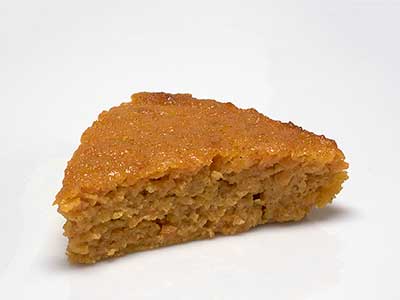May 25, 2015
Mignardise

pudding aux carottes
(carrot pudding)
It was the first old recipe that ever interested me. The recipe was called rafioli comun de herbe vantazati. It was ravioli filled with spinach or beet leaves, ricotta, raisins, cinnamon, and nutmeg. The “sauce” was a sprinkling of Parmesan cheese. The recipe was an adaptation of one from the fourteenth century. The results were quite tasty, but in those days it seemed like a lot of work.
Before my full-time interest in Chinese cookery, I was cooking lots of noodles. In some perverse way, I moved into Chinese cookery because I found the noodles of Asia more interesting than the noodles of Europe. This old ravioli recipe was one of 22 that I highlighted in Anna Del Conte’s Portrait of Pasta when I purchased the book in $7.95 1976. It felt somehow good to be preparing a six-hundred-year-old recipe, even in an adapted form.
Although I never saw the original version of that recipe, not that I could even read ancient Italian, I became curious about old recipes. In those days, even recipes from fifty years earlier were somewhat of a mystery to me.
A few years after my adventures in pasta waned, I picked up what at the time was my oldest cookbook. The Harrisburg Telegraph Cook Book set me back $9.00 when I found a nice used copy of it around 1980. It was published in 1908, and originally sold for one-dollar. As the newspaper advertised 1911,
THIS book has been made especially for the women readers of the Harrisburg Telegraph who appreciate good cooking and who are always on the lookout for something new. OUR Cook Book contains numerous famous receipts of dishes, both European and Domestic, conveniently arranged in chapters, with subdivisions, enabling one to find a receipt with minimum delay. AN important feature is the following special chapters, not found in most Cook Books: Candies, Preserves, Summer Drinks, Jellies, Salads, Dishes For Invalids Menus, Ices, Cookies, Etc., Etc.
The book gave an insight into the cooking of the time without the preaching found in the cookbooks by the domestic science mavens of the period. There were dishes that seemed ordinary even seventy years after it was printed, and there were dishes that I couldn’t comprehend, like mushroom catsup.
But that was then. Today, I’m more likely to be found with my nose in an eighteenth-century cookbook as a modern one. And these old recipes are no longer a mystery. Often I wonder why the old recipes are ignored in favor of modern, complicated versions. I realize that there are advantages to modernization: heat at the flip of a switch, food available all year round, modern cookware, refrigeration, etc. Nonetheless there are things to be learned from old recipes. Today, I think I get more ideas from old recipes than I do from modern ones. For example, carrot pudding from Amelia Simmons’ American Cookery. First published in 1796, there were thirteen known editions of the book between then and 1831. It is considered the first cook book written by an American. The carrot pudding recipe that caught my attention is from page 28 of the 1798 edition.
A coffee cup full of boiled and strained carrots, 5 eggs, 2 ounces sugar and butter each, cinnamon and rose water to your taste, baked in a deep dish without paste.
This is from a time when puddings were a much more general dish than just the dessert we know of today. One of the definitions provided by the OED is “A preparation of food of a soft or moderately firm consistency, in which the ingredients, animal or vegetable, are either mingled in a farinaceous basis (chiefly of flour), or are enclosed in a farinaceous ‘crust’, and cooked by boiling or steaming. Preparations of batter, milk and eggs, rice, sago, tapioca, and other farinaceous substances, suitably seasoned, and cooked by baking, are now also called puddings.” Preparations like black pudding, what others call blood sausage, gets the pudding moniker because the contents are packaged in the entrails of a pig.
My version of this pudding produces 4 to 6 servings as a mignardise, depending on how you bake and serve it.
75 g (2-5⁄8 oz)
carrot puree, see note
15 g (4 t)
finely granulated sugar
1⁄16 t
ground cinnamon
15 g (1 T)
soft butter
1 large
egg, well beaten
1⁄8 t
rose water
1. Preheat oven to 220 °C (430 °F). Heavily butter a 10-cm (4-in) tart pan.
2. Briefly whisk the puree, sugar, and cinnamon together. Add the soft butter and whisk to incorporate. Whisk in the egg and rose water. Pour the mixture into the prepared tart pan, and level the surface.
3. Bake until done in the center. The edges may start to appear dry.
4. To serve, spoon out individual portions from the tart pan.
Note: To prepare the carrot puree, cook the carrots in a microwave until the centers are softened, about 5 minutes. When cool, puree the carrots by forcing them through the fine screen of a food mill or through a fine sieve.
Yield: 6 portions.
© 2015 Peter Hertzmann. All rights reserved.
